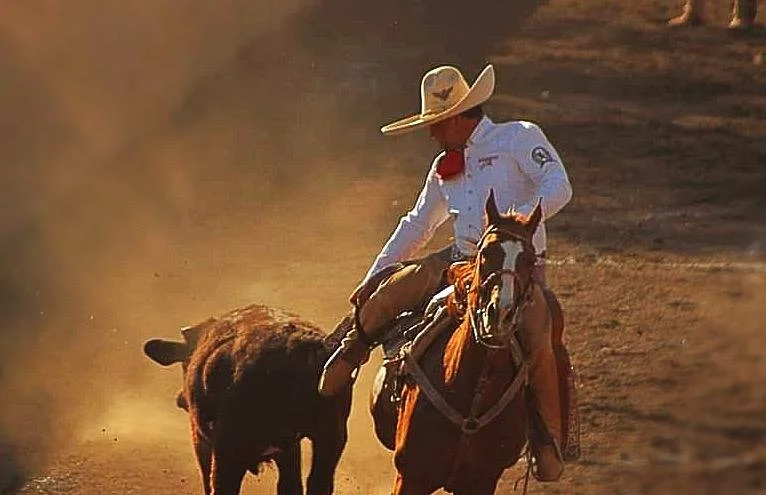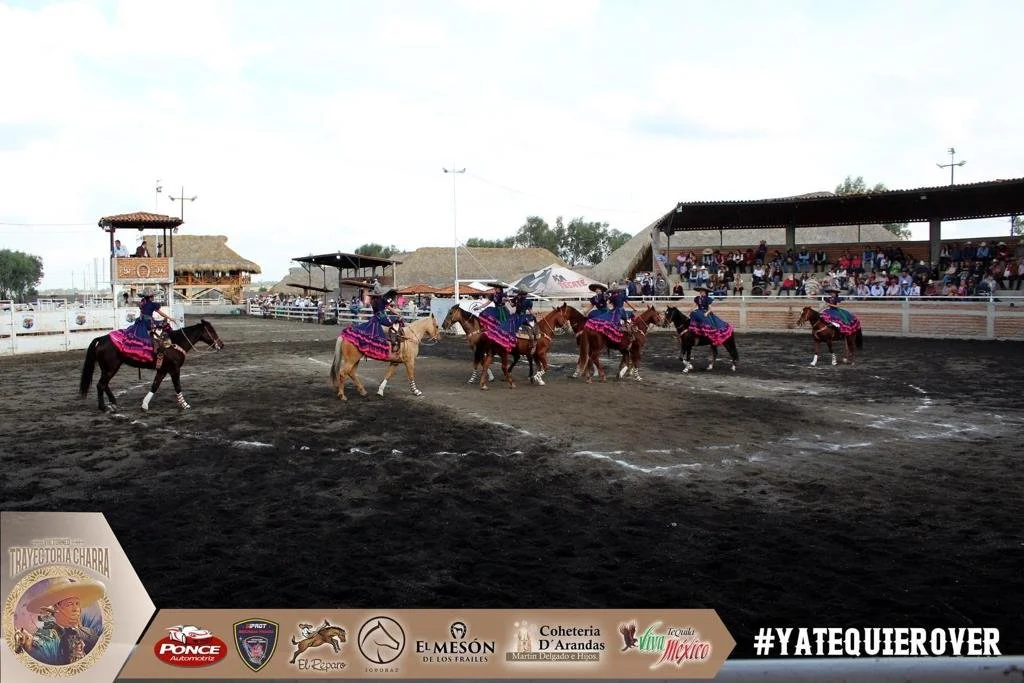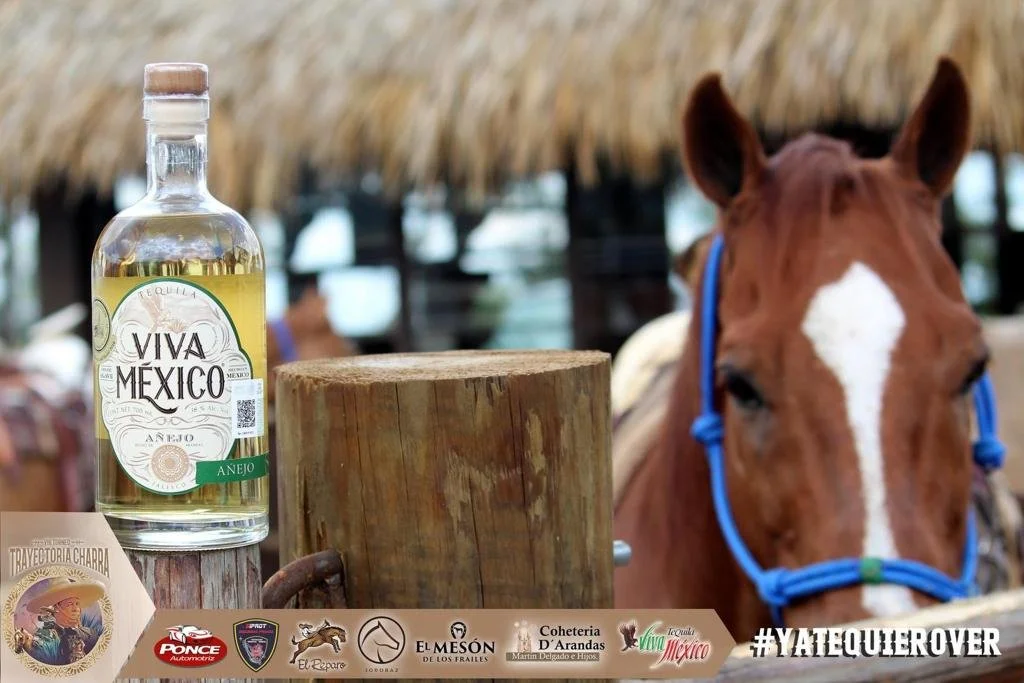Galloping traditions at the heart of Arandas
by Alfonsina Betancourt
José Manuel Vivanco Hernández, charro and part of the Vivanco family of Viva Mexico Tequila
Growing up in Arandas, a small city in Los Altos of Jalisco, José Manuel Vivanco Hernández learned from an early age to honor the culture of his land and the traditions of his ancestors. With several generations of agave growers in his bloodline, his grandfather, Feliciano Vivanco, founded Casa Tequilera Viva México, a brand recognized for its handmade, fine tequila. However, Jose Manuel's interests extended well beyond the distillery into the adjacent ranch.
It all started with his grandmother, who could be seen riding her favorite mare, La Bruja, at the family ranch. The next generation began investing in horses to grow their family stock. Their strength and nobility have offered a particular fascination for the young boy who learned to ride them as soon as he could walk. It wasn't until he attended one Charrereada event and saw boys his age competing that he realized that it was something he could also do. And so, Jose Manuel embarked on the rewarding path to becoming a Charro until he became federated in 2009.
The equestrian culture was imported to Mexico during the Spanish Colonial times. It quickly grew roots mixed with the most important Mexican traditions, giving birth to what is known as Charrería. This sports discipline goes well beyond typical horse competitions. They are multi-sensorial experiences where the spectator can enjoy the ability of riders wearing traditional costumes and performing suertes or elaborated tricks on a horse while listening to mariachis and, of course, sipping a good tequila. A true family event, relatives enjoy Charrería together, from grandparents to children.
The Charrería runs so deep in the Mexican tradition that it is more a way of living than a form of entertainment. Charros proudly practice the national sport, and they are also part of Mexico's military force. It is not a surprise then that a special reverence is reserved for this cultural heritage.
Charreria Event. Photo by Splash, courtesy of Viva Mexico Tequila
Those who earn the right to dress up as a Charro know that it is an honor and a duty. As if each outfit was sewn with threads of history and Mexican pride, the traditional costumes convey the obligation to behave appropriately and represent the country's values. Whether it is a faena outfit without the jacket or the half-gala, gala, or the grand-gala fashion reserved for special events, these Mexican men can be recognized worldwide by their short jackets, tight pants, silk ties, and wide-brimmed sombreros. When dressed for the part, a charro always draws the attention of those present, especially the girls who admire the elegance and bearing of Mexico’s finest. Women who participate in these events are called escaramuzas, which means "skirmish." They wear colorful dresses that allow them to ride their horses sideways. Unlike other horse competitions such as dressage and rodeo, Charrerías offer a show that combines elegance, bravery, and a great command of the horse. Among the more than ten Charros tasks, Cala de Caballo (Testing of the Horse), favored by Vivanco Hernández, tests the obedience and strength of the horse while performing complex tasks. Colas de Lienzo (Bull Tailing) requires the rider to bring down a bull from a short distance. The lasso masters the art of using the ties, while El Paso de la Muerte (The Pass of Death) requires the rider to mount from his bareback with-reins horse to a running bareback horse without reins until he makes it stop in its tracks. It is clear where Charros have gained their brave reputation.
Jalisco is the home of tequila, charreadas, and mariachis, the foundations of the most popular Mexican traditions. Vivanco's well-respected family has honored them and made them part of their mission.
Casa Tequilera VIva México lays their ranch with about 40 horses, including Quarter Horses, who are very valued for their versatility, intelligence, and agility when performing the Charrería tasks. Visitors can enjoy a ride and delight in the beauty of these animals. They have also offered equine therapies for people with psycho-motor disabilities and lend the space for escaramuzas to practice their synchronized-dance-like rides.
Escaramuzas at Trayectoria Charra
There is a special connection that is established with each of these horses. Aside from working at the family distillery in different capacities, including bottling development and client services, Jose Manuel still takes time to bond with his animals through grooming, baths, and the always special horse rides. The Vivancos knew that their love for horses and their commitment to the sport and art of Charrería needed more than moral support. For the last ten years, they have sponsored their own Tequila Viva Mexico team, where José Manuel Vivanco Hernández is one of its members. They also support one annual event in the fall named Trayectoria Charra.
With events occurring most of the year, nothing is more colorful than the Independence celebration on September 16 every year. For four consecutive Thursdays before that, hundreds of riders enter the city and ride around the main square. Traditionally, men will throw a flower at any woman they wanted to woo. If the woman liked the man, she would accept the flower and jump on the horse with the object of her affection. Walk around Jalisco and you will hear beautiful love stories that began that way.
Tequila and Charreadas have many things in common beyond their origin. They are both pillars of unique Mexican traditions, and they involve a way of enjoying life as a community. Tequila is sipped among those who come to witness a Charrería, and it helps to create bonds between them. After the challenging tasks he performed, a good Charro deserves an excellent tequila to forget if he lost or to celebrate if he won. But what tequila is better enjoyed at these events? You can mostly see Blanco or Reposado, but any good artisanal tequila will match the occasion. If we ask José Manuel Vivanco Hernández, part of a well-renowned clan of tequileros and a dedicated Charro, he would tell you that a Tequila Viva Mexico would allow you to taste the love his family has offered to the prosperous land of Jalisco, the exquisite juice produced following an artisanal process, the smell of the blue agaves being baked, the galloping of their horses, the color of their traditional outfits, the notes of a Mariachi in the background, and especially the pride of sharing their Mexican heritage that has run through their veins for generations.
Stay tuned for Hidden Gem Tequila Events that will bring you to the core of the beautiful Jalisco to learn about Artisanal Tequilas such as Viva Mexico and its rich equestrian culture. To learn about Tequila experiences, visit: Experiences
To learn more about Tequila Viva Mexico visit our Distillery Page. You can also visit Tequila Viva Mexico's website.






